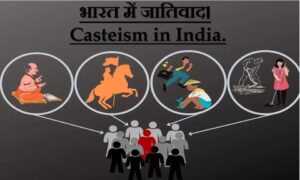

Casteism in India


(Relevant for Sociology Optional for Civil Services Examination)
Paper 2: Social Changes in India; Challenges of Social Transformation

CASTEISM IN INDIA
“Casteism is an overriding, blind and supreme group loyalty that ignores the healthy social standards of justice, fair play, equity and universal brotherhood.”
KAKA KELEKAR
- The caste system in its distorted form has given rise to the problem of casteism. It has crept into every sphere of our national life. As a result of casteism people have started to ignore the interest of society. Casteism which exercises a negative influence on the network of social relations is caused by several factors of which the following may be noted:
- Endogamous Nature of the Caste: It means that members of a caste or sub caste have to marry within his or her own caste or sub-caste. Individuals are more prone to develop their loyalties and admiration to their own caste or sub caste people.
- Strong Desire of Enhance Caste Prestige: Every member of a caste group tries his level best to see that his caste prestige is safeguarded and enhanced. This type of loyalty towards the caste makes the members of the caste favour the members of his or her caste wherever they get the opportunity. Excessive caste loyalty tends to keep other caste people at a distance.
- Better Organization of Caste: due to advancement of communication and transportation techniques helps in the consolidation of caste based organisations.
- Urbanization Indirectly Favouring Casteism in India: When the rural people go to cities they consider their own caste people as their potential friends and well-wishers. Hence the city atmosphere has also contributed to the strengthening of caste feeling and caste- mindedness.
- Powerful Hold of the Caste Over the member: Caste is a strong cohesive group. It has a powerful hold over its members. Caste members seek support from their own caste during crises and emergencies. Hence caste as source of social capital, economic capital and symbolic capital enforces the casteism.
Consequences of Casteism in India
- Members of the caste imbibed with the spirit of casteism are more prone to show their loyalty to the caste rather than to the community at large. Casteism divides people in the name of caste and encourages intolerance, jealousy, rivalry and conflicts among members of the caste.
- Caste and democracy are fundamentally incompatible. Caste, rooted in inequality, clashes with democracy’s principles of equality and equal opportunities. In Indian politics, caste complexities lead to selection, cabinet formation, and portfolio distribution. Tensions, rivalries, and undermine national unity, affecting candidate.
- Casteism leads to the negligence of talents and efficiency. If candidates are selected and appointments are made on the basis of caste, it definitely damages talents, abilities and efficiencies of the people. When unwanted and inefficient people are selected for high offices in the name of caste, honesty, efficiency and duty consciousness becomes the first casualty.
- More than the common people, politicians seem to be contributing much to the survival of casteism. “Political leaders belonging to different castes seem to secure political and other advantages for themselves at the expense of other, and to this end they utilize the caste sentiment. Caste consciousness and caste prejudices which exist among the masses are thus turned by politicians into caste passions.”
Suggestions for solution of the problem of Casteism in India
- According to Ghurye, the conflicts originated in casteism can be removed by encouraging inter caste marriages.
- Necessary precautions must be taken to see that the word ‘caste’ is used only in limited context. The young generations must be encouraged to give the least importance to it. This is possible only when we make lesser use of the term ‘caste’.
- According to Mrs. Iravati Karve, in order to put an end to the conflict arising out of casteism it is necessary to create economic and cultural equality between the castes.
- According to Prabhu, the conflict created by casteism can be ended only when the internal aspects of conduct are influenced. For this it is necessary to try and develop new attitudes in the people. The cinema can do much towards the much towards the creation of these attitudes.
- N. Srinivas opinion most of the shortcoming of the caste system can be removed and the door opened to democratic equality through adult franchise, five year plans, and the provision of education, constant progress of the backward classes and the influence of the culture of higher caste on the living standards of the lower castes.
Lastly it can be concluded that caste and caste conflict is still prevalent. However nature, form and genesis of caste and caste conflict have changed. Presence of caste and caste conflict is a testimony to the fact that there is a contrast between traditional cultural perceptions and modern values of equality and justice.
Pages: 1 2

One comment